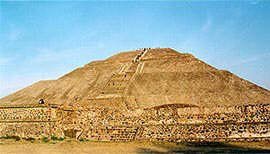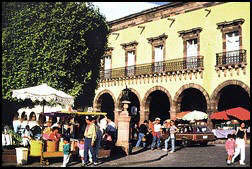 HISTORY HISTORY |
As early as 40 000 years ago, prehistoric man roamed across the Bering Strait, leaving Asia and entering the territory that would come to be called America. In their pursuit of game, these early nomads crossed into the uninhabited lands of the Western Hemisphere.
By 10 000 B.C, clans of hunter-gatherers were scattered throughout the continent. As subsistence patterns changed and farming took precedence over hunting, many settled in the fertile regions of Mesoamerica. Others wandered farther south, their descendants eventually reaching the tip of Argentina.

The first highly developed civilization to emerge in the New World belonged to the Olmecs, who flourished between 1200 and 500 B.C in the lowland jungles of Veracruz and Tabasco. Today, the Olmecs are most readily identified with the massive stone heads they sculpted. They developed a calendar and hieroglyphic writing. And aspects of their religion, architecture, art and an elementary numerical system were expanded on for centuries to come.
Many of the wandering tribes started congregating in Central Mexico. Some of these people built Teotihuacan, a name the Aztecs gave to it, which means " Place where Gods are made ". Teotihuacan was a true city that has counted a population of about 200 000 around 500 A.D. before falling in ruins until the arrival of the Aztecs.
Also Cholula, close by Puebla, managed to survive as a religious centre and was still a revered city at the time of the Spanish Conquest in 1521. Simultaneously, the Maya were busy building great cities, which today are largely buried in the rain forests of Guatemala and Chiapas.
The Toltecs became known to later generations as possessors of all that was fine in richly-decorated temples, elegant speech and intellectual pursuits. The Toltec city of Tula was the home of Quetzalcoatl, the most prominent gods of Mesoamerica, and here history and legend intertwine. Through deception by the god Tezcatlipoca, the fair Quetzalcoatl was forced to flee to Tula and head east to the Yucatan Peninsula, where he became known as Kukulcan.
In 1492, when Columbus arrived in the New World, the Aztec Empire was strong and growing. (Emperor Ahuitzotl was engaged in a four-year campaign to add pacific coast lands around present-day Acapulco to his realm). It controlled vast lands stretching from the Yucatan Peninsula to the pacific, with at least 370 individual nations subject to their capital city Tenochtitlan.
The Aztecs' demand for heavy tribute was a significant factor in their downfall. After two difficult years and the loss of many lives, especially among the Indians, who were decimated by the smallpox germ imported by the Conquistadors, the Spaniards defeated the Aztecs under their last ruler, Cuauhtemoc. Thus began 300 years of colonial rule.
Religious fervour and greed were two driving forces in colonization. In every town, native Indians newly converted to Catholicism were forced to construct churches, many built from the rubble of demolished pre-hispanic temples, such as at Tenochtitlan, today Mexico City.
Over the next 300 years, Spain sent 61 viceroys to govern New Spain. Many beautiful buildings were constructed, which are still in use today. Spanish speech, dress and customs replaced indigenous cultures in the cities, but always with adaptations to the climate and the unique way of life in the vast new country.
Father Miguel Hidalgo, a priest from the town of Dolores, was instrumental in cutting ties with Spain. His impassioned plea to his countrymen on September 16th, 1810, stirred them to recover the lands stolen 300 years ago from your forefathers by the hated Spaniards. The image of the revered dark-skinned Virgin of Guadalupe, dear to all Mexicans, was wisely chosen as the emblem of the independence movement. It was the first decisive step toward Mexican independence, which would come 12 years later.
In 1824, a constitution was adopted and Mexico's first president, Guadalupe Victoria, was sworn into office. But stability was short lived as between 1833 and 1855 the Presidency changed hands 33 times. Eleven years later the Mexico-United States border and the ownership of the territories of California and New Mexico were still a subject of dispute. U.S General Winfield Scott's army landed in Veracruz in March 1847 and marched to the capital.
In 1861, with Santa Anna ousted for the last time, a Zapotec Indian from the State of Oaxaca was elected president. Benito Juarez became a lawyer before being elected governor of his State. The story of his success against great odds and the struggles of his presidency make him one of Mexico's most beloved historical figures. In 1867, he was elected to a third term. Among his accomplishments were completion of a railroad connecting Mexico City and Veracruz, and reorganization of the Educational system, making primary school attendance free and obligatory.
 | For a third of a century (1876 - 1910), Mexico was in the hands of dictator Porfirio Diaz. This was a period of rapidly developing industry, an expanded railway system and extensive foreign investment. But this development only made Mexican's lives unendurable and set the stage for revolution.
Six years of fighting ended the Porfiriato and brought into prominence men like Emiliano Zapata, Fransisco Madero y Pancho Villa. November 20, a national holiday, honours the beginning of the 1910 Revolution.
At the end of the Revolution, for the first time since Cortes captured Cuauhtemoc, Mexicans were in control of Mexico. A minimum wage was established and workers were allowed collective bargaining and the right to strike. The power of the church was considerably reduced.
For over 70 years to the present day, the PRI has been the ruling party of Mexico. The speed of transformation of this country in to a major world player in the economy and one of the top tourist destinations in the world has been rapid. Among its industry, the city of Monterey was voted top Latin American city to do business and boasts the top educational institutions in the region, Monterrey Tec. Mexico city is still the centre of business but other cities are growing quickly offering options of varying degrees to potential investors. Mexico also has more free trade treaties than any other country in the world, an example of the initiative it has in becoming a top world economy. Throughout its modernisation, the country has not lost sight of its cultural heritage. Most areas of the country are examples of the mix of its history and the business culture that it has adopted from it's neighbours, the United States. The latter being the strongest influence on any emerging market in the Latin World.
 Important dates in Mexican history Important dates in Mexican history |
 B.C B.C |
1200 Height of Olmec civilization
31 Earliest recorded calendar date in New World
 A.D A.D |
100-700 Teotihuacan influence spreads, declines
600-900 Height of Maya civilization
600-1200 El Tajin (Gulf Coast), Monte Alban, Mitla (Oaxaca) flourish
987 Queztalcoatl departs from Tula
1168 Fall of Tula, Toltec capital
1325 Tenochtitlan founded
1428 Defeat of Tepanecs of Atzcapotzalco
1472 Death of Nezahualcoyotl of Texcoco
1517 Cordoba's expedition to Yucatan
1519 Cortes land in Veracruz (April 21)
1521 Fall of Tenochtitlan (August 13)
1535 First Spanish viceroy arrives in Mexico
1810 Father Hidalgo's " grito ", start of War of Independence from Spain (Sept. 15)
1822 Gen. Agustin de Iturbide declares him emperor (May 19)
1824 First president elected. Constitution adopted
1847 Gen. Winfied Scott victorious at Chapultepec Castle (Sept. 13)
1855 Benito Juarez elected president
1857 New constitution adopted with bill of rights, abolition of slavery
1862 Battle of Puebla (May 5)
1864-67 French intervention
1876-1910 Porfirio Diaz dictatorship
1910 Start of the Revolution (November 20)
1917 New constitution adopted. Revolution continues another 3 years
1938 Nationalization of oil companies (March 18)
1952 University City completed
1964 National Museum of Anthropology opens
1974 Quintana Roo, Baja California Sur last states to join the Republic
1978 Aztec Templo Mayor discovered in Mexico City
1982 Private banks nationalized
1991 Re-privatization of banks
1994 North American Free Trade Agreement goes into effect; Indian rebels in Chiapas launch uprising
1997 Mexico City makes democratic transition from president-appointed regent to popularly elected mayor. |

